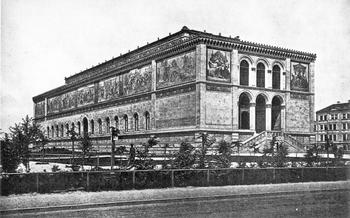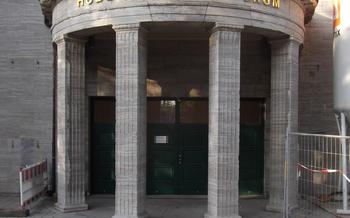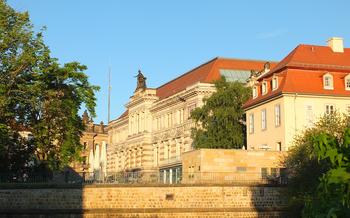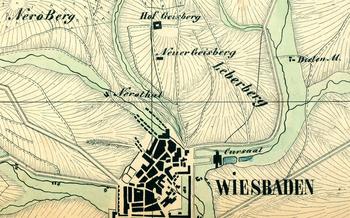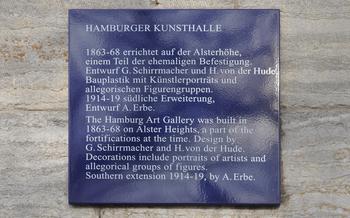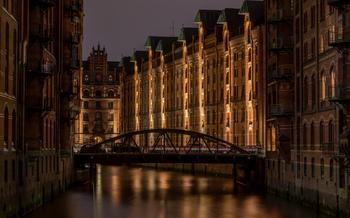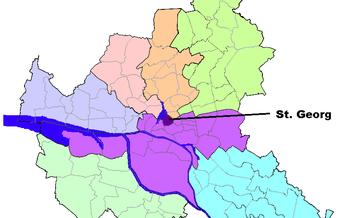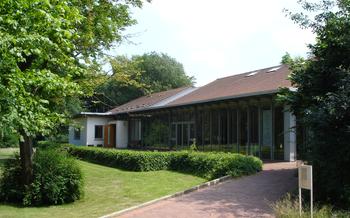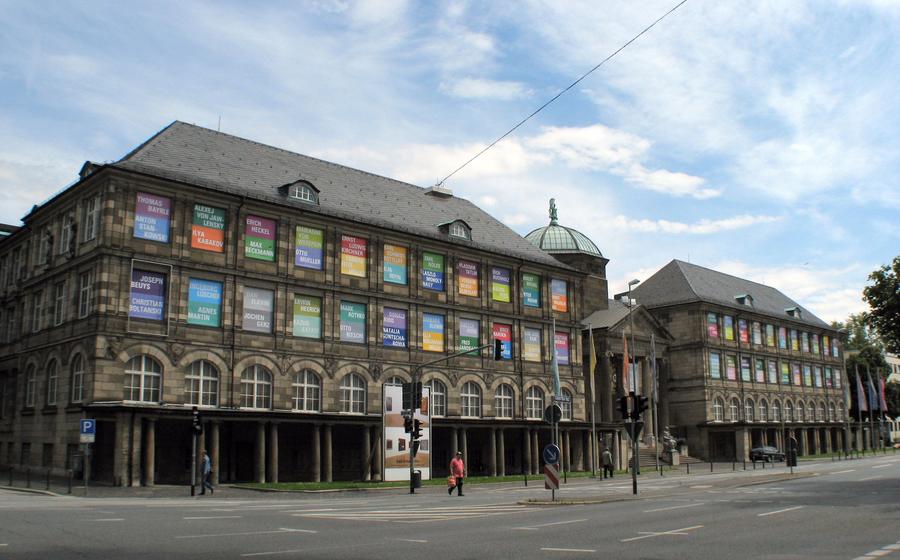
Museum Wiesbaden
- Museum Wiesbaden: A Treasure Trove of Art and History
- Exploring the Permanent Collection
- The Highlights of the Collection
- Special Exhibitions and Events
- Planning Your Visit
- Navigating the Museum's Galleries
- Unveiling Wiesbaden's Artistic Legacy
- Engaging Educational Programs
- Museum Shop and Café
- Museum Wiesbaden for Families
- Photography and Social Media
- Accessibility and Inclusivity
- Sustainability Initiatives
- Community Outreach and Partnerships
- Insider Tip: Hidden Gems of the Museum
Museum Wiesbaden: A Treasure Trove of Art and History
Nestled in the heart of Wiesbaden, Germany, the Museum Wiesbaden stands as a testament to the city's rich cultural heritage and artistic legacy. Founded in 1825, the museum boasts a diverse collection of over 300,000 objects, spanning various eras and artistic movements. With its impressive neoclassical architecture, the museum itself is a sight to behold, attracting visitors from around the world.
The Museum Wiesbaden has played a pivotal role in preserving and showcasing the artistic achievements of Wiesbaden and beyond. Its diverse collection includes ancient Egyptian artifacts, Greek and Roman antiquities, medieval and Renaissance artwork, as well as modern and contemporary masterpieces. Visitors can embark on a journey through time, exploring the evolution of artistic expression and the diverse cultural influences that have shaped the region.
Among the museum's unique features is its stunning architecture. Designed by renowned German architect Friedrich von Thiersch, the building is a masterpiece of neoclassicism, characterized by its imposing columns, intricate carvings, and grand entrance. The museum's interior is equally impressive, with spacious galleries, high ceilings, and natural light flooding in through large windows.
Exploring the Permanent Collection
The Museum Wiesbaden houses an impressive permanent collection that spans various eras and cultures, offering visitors a diverse artistic journey. One of the highlights is the Ancient Egyptian collection, which boasts a remarkable array of artifacts, including statues, mummies, and intricate hieroglyphic inscriptions. These ancient treasures provide a glimpse into the fascinating civilization of the pharaohs.
The Greek and Roman antiquities section showcases a wealth of sculptures, pottery, and jewelry, offering a glimpse into the classical world. Visitors can admire graceful marble statues, intricate mosaics, and finely crafted bronze objects, gaining an understanding of the artistic achievements of these ancient civilizations.
The museum also boasts an impressive collection of medieval and Renaissance artwork, featuring paintings, sculptures, and tapestries from the Middle Ages to the early modern period. This section showcases the transition from the Gothic to the Renaissance style, with works by renowned artists such as Albrecht Dürer, Lucas Cranach the Elder, and Hans Holbein the Younger.
Finally, the museum's modern and contemporary collection features a diverse range of works from the 19th and 20th centuries. Visitors can explore paintings, sculptures, and installations by renowned artists such as Claude Monet, Auguste Rodin, Pablo Picasso, and Andy Warhol, gaining an understanding of the evolution of artistic styles and movements over the past two centuries.
The Highlights of the Collection
Among the many masterpieces housed within the Museum Wiesbaden's walls, several stand out as must-see highlights for any visitor. One such gem is Lucas Cranach the Elder's "Portrait of a Young Man", a captivating depiction of a young man with a piercing gaze and intricate details that showcase the artist's mastery.
Another highlight is Claude Monet's "Water Lilies", a breathtaking impressionist landscape that captures the essence of the artist's unique style with its vibrant colors and ethereal brushstrokes. The museum also boasts Auguste Rodin's iconic sculpture "The Thinker", a profound representation of contemplation and human intellect, rendered in bronze with exquisite craftsmanship.
Finally, the Egyptian Book of the Dead, an ancient papyrus scroll inscribed with hieroglyphs and intricate illustrations, offers a glimpse into the fascinating beliefs and funerary practices of ancient Egyptian civilization. These highlights, along with numerous other treasures, make the Museum Wiesbaden a must-visit destination for art and history enthusiasts alike.
Special Exhibitions and Events
In addition to its permanent collection, Museum Wiesbaden also hosts a variety of temporary exhibitions throughout the year. These exhibitions showcase a diverse range of themes, from ancient civilizations to contemporary art. Past exhibitions have explored topics such as the history of photography, the art of the Renaissance, and the works of famous artists like Picasso and Van Gogh.
The museum also offers guided tours and workshops in conjunction with its special exhibitions. These tours provide visitors with an in-depth look at the exhibits and allow them to learn more about the featured artists and themes. Workshops offer hands-on experiences, such as painting or sculpture classes, that allow visitors to engage with the art in a more interactive way.
Lectures, concerts, and cultural programs are also regularly held at the museum. These events provide visitors with the opportunity to learn more about art and culture in a variety of ways. Lectures by experts in various fields offer insights into the history, techniques, and significance of art. Concerts and performances showcase the talents of local and international artists, while cultural programs explore the connections between art and other disciplines, such as music, literature, and dance.
Planning Your Visit
Before embarking on your artistic journey at Museum Wiesbaden, it is essential to plan your visit to make the most of your experience. The museum welcomes visitors during its opening hours, which typically fall between 10 AM and 6 PM, Tuesday through Sunday. To fully immerse yourself in the museum's treasures, consider allocating at least two to three hours for your visit.
Admission fees are nominal and vary depending on the type of ticket. Regular admission grants access to the permanent collection and temporary exhibitions, while concession tickets are available for students, seniors, and groups. Be sure to check the museum's website for current pricing and any special offers or discounts that may be available.
Accessibility is a priority at Museum Wiesbaden, ensuring that all visitors can enjoy the wonders of art. Wheelchair users and visitors with limited mobility will find ramps and elevators throughout the museum, making it easy to navigate the galleries. Additionally, the museum offers audio guides and descriptive panels for visually impaired visitors, allowing them to fully appreciate the artworks. Multilingual signage and brochures are also available, catering to international guests and ensuring that everyone can understand and engage with the museum's exhibits.
Navigating the Museum's Galleries
The Museum Wiesbaden is a labyrinth of galleries, each dedicated to a different era or artistic movement. To make the most of your visit, it's helpful to understand the museum's layout and the highlights of each gallery.
Thematic Arrangement: The galleries are arranged thematically, allowing visitors to trace the evolution of art through the ages. Ancient Egyptian artifacts and sculptures are displayed in one section, while Greek and Roman antiquities are showcased in another. Medieval and Renaissance artwork, as well as modern and contemporary masterpieces, each have their own dedicated spaces.
Maps and Guides: To assist visitors in navigating the museum's vast collection, maps and guides are available at the information desk. These resources provide an overview of the galleries and highlight must-see artworks. Visitors can choose to follow a suggested route or explore at their own pace.
Highlights of Each Gallery: Each gallery boasts its own unique treasures. In the Ancient Egyptian gallery, visitors can marvel at the intricately carved statues of pharaohs and gods. The Greek and Roman gallery houses an impressive collection of sculptures, pottery, and jewelry. The Medieval and Renaissance gallery features stunning paintings and tapestries from the Middle Ages and the Renaissance period. The modern and contemporary gallery showcases works by renowned artists such as Pablo Picasso, Wassily Kandinsky, and Andy Warhol.
Unveiling Wiesbaden's Artistic Legacy
Museum Wiesbaden takes pride in its role as a custodian and promoter of Wiesbaden's artistic heritage. The museum showcases the works of renowned local artists, paying homage to their contributions to the city's cultural landscape. Visitors can admire paintings, sculptures, and other artworks created by talented Wiesbaden artists, providing a glimpse into the city's rich artistic traditions. These local masterpieces not only reflect the unique character of Wiesbaden but also contribute to the museum's diverse and comprehensive collection.
Among the notable Wiesbaden artists featured in the museum are: - Wilhelm Trübner, a prominent Impressionist painter known for his vibrant landscapes and portraits. - Fritz Winter, an abstract expressionist whose works explore the themes of destruction and renewal. - Lili Elbe, one of the first transgender women to undergo gender-affirming surgery, whose self-portraits offer a poignant insight into her personal journey.
By showcasing these local talents, Museum Wiesbaden celebrates the artistic legacy of Wiesbaden, honoring the contributions of its creative minds to the city's cultural tapestry.
Engaging Educational Programs
The Museum Wiesbaden offers a plethora of engaging educational programs for visitors of all ages. Workshops and classes are conducted throughout the year, catering to both adults and children. These programs provide a unique opportunity to learn more about art history, techniques, and the creative process. Participants can engage in hands-on activities, such as painting, drawing, and sculpting, under the guidance of experienced instructors.
Interactive exhibits are strategically placed throughout the museum, inviting visitors to explore and learn in a fun and engaging way. These exhibits incorporate multimedia elements, interactive displays, and hands-on experiences that bring the artwork to life. Visitors can immerse themselves in the world of art through virtual reality tours, augmented reality applications, and touchscreens that provide in-depth information about the exhibits.
The museum also provides educational resources and materials for teachers and students. These resources include lesson plans, worksheets, and activity guides that align with school curricula. Teachers can utilize these materials to enhance their art history lessons and provide students with a deeper understanding of the museum's collection.
Museum Shop and Café
The Museum Wiesbaden houses a well-stocked museum shop where visitors can find a variety of unique souvenirs and art-inspired merchandise. Whether you're looking for a commemorative gift, a piece of art for your home, or a fun and educational toy for your children, you're sure to find something special here. From postcards and posters featuring the museum's highlights to replicas of ancient Egyptian sculptures and medieval manuscripts, the shop offers a wide range of items to suit every taste and budget.
The on-site café invites visitors to take a break from their exploration of the museum to enjoy a refreshing beverage or a light meal. The menu features a variety of hot and cold drinks, as well as a selection of sandwiches, pastries, and cakes. Whether you're looking for a quick snack or a leisurely lunch, the café is the perfect place to relax and refuel before continuing your journey through the museum's galleries.
In addition to the shop and café, the museum also offers a relaxation area where visitors can rest and reflect on their experience. Comfortable seating and ambient lighting create a welcoming and serene atmosphere, making it the ideal place to take a moment to absorb the beauty and significance of the museum's collection.
Museum Wiesbaden for Families
The Museum Wiesbaden has not forgotten its younger visitors. Families are welcomed with open arms and provided with a variety of activities and programs to make their visit both educational and enjoyable. From interactive scavenger hunts to hands-on workshops, there's something for children of all ages to discover and explore.
One of the highlights for families is the museum's "Family Sunday" program. Held on the first Sunday of every month, this special event features guided tours, art workshops, and storytelling sessions designed specifically for children. There's also a "Kids' Corner" in the museum, where little ones can let their creativity run wild with coloring books, puzzles, and other fun activities.
To make the most of your family visit, be sure to pick up a "Family Guide" at the museum's information desk. This guide provides a self-guided tour of the museum's highlights, with kid-friendly explanations and activities along the way. And don't forget to check the museum's website for information on upcoming family events and programs.
Photography and Social Media
The Museum Wiesbaden encourages visitors to capture and share their experiences within its walls. Photography is generally permitted for personal, non-commercial use. Visitors are welcome to take photographs of the museum's artwork and exhibits, but the use of flash or tripods may be restricted in certain galleries. To ensure the safety of the artworks and the enjoyment of all visitors, it is important to be respectful and considerate when taking photos.
The museum also embraces the power of social media to connect with a broader audience and share its treasures with the world. Visitors are encouraged to share their photos, comments, and experiences on social media platforms using the hashtags #MuseumWiesbaden and #ArtInWiesbaden. The museum's social media accounts provide regular updates on new exhibitions, events, and behind-the-scenes glimpses, offering followers a deeper connection to the museum's collection and activities. By sharing their experiences, visitors become part of a vibrant online community of art enthusiasts, connecting with others who share their passion for art and history.
Accessibility and Inclusivity
The Museum Wiesbaden is committed to providing an accessible and inclusive environment for all visitors, regardless of their abilities or backgrounds. The museum features wheelchair accessibility and ramps throughout the building, ensuring that visitors with mobility impairments can navigate the galleries and exhibitions comfortably. Additionally, audio guides and descriptive panels are available for visually impaired visitors, providing them with a rich and immersive experience. To cater to international guests, the museum offers multilingual signage and brochures, making the exhibits accessible to visitors from diverse linguistic backgrounds. The museum's commitment to inclusivity extends beyond physical accessibility; it also strives to create a welcoming and supportive environment for visitors from all walks of life. The staff is trained to be attentive and accommodating, ensuring that everyone feels respected and valued. Through its accessibility and inclusivity initiatives, the Museum Wiesbaden demonstrates its dedication to providing a positive and enriching experience for all visitors.
Sustainability Initiatives
The Museum Wiesbaden is committed to environmental sustainability and takes proactive steps to reduce its ecological footprint. The museum has implemented energy-efficient lighting and climate control systems to minimize energy consumption. It also actively promotes recycling and waste reduction measures throughout the institution. Visitors are encouraged to participate in these initiatives by properly disposing of their waste and using the recycling bins provided. By embracing sustainable practices, the museum sets a positive example for other cultural institutions and demonstrates its commitment to protecting the environment for future generations.
Community Outreach and Partnerships
Museum Wiesbaden actively engages with the local community and collaborates with various art institutions and educational organizations. This outreach program aims to foster a sense of inclusivity, promote art education, and make the museum accessible to a broader audience.
The museum partners with local schools to offer educational programs, workshops, and guided tours tailored to different age groups. These programs focus on art appreciation, history, and hands-on experiences, encouraging students to explore their creativity and develop a lifelong love for art.
To reach underserved communities, the museum collaborates with non-profit organizations and community centers to provide free or discounted admission, guided tours, and art workshops. These initiatives aim to break down barriers to access and ensure that everyone has the opportunity to experience and engage with the museum's collections.
The museum also actively participates in cultural events and festivals throughout the year. These events provide a platform for the museum to showcase its collection, engage with the public, and promote the arts within the community.
By fostering partnerships and engaging in outreach activities, Museum Wiesbaden plays a vital role in promoting cultural understanding, education, and inclusivity within the city and beyond.
Insider Tip: Hidden Gems of the Museum
Beyond the renowned masterpieces, Museum Wiesbaden holds secret treasures waiting to be discovered. Venture off the beaten path to uncover hidden nooks and lesser-known exhibits. Explore the museum's collection of antique toys, hidden in a secluded corner, or marvel at the intricate details of the medieval tapestries displayed in a dimly lit room.
Ascend to the rooftop terrace for a breathtaking panoramic view of Wiesbaden's cityscape, with its spires and domes reaching towards the sky. This hidden gem offers a unique perspective and a moment of tranquility amidst the vibrant city.
Keep an eye out for special events and after-hours tours that provide exclusive access to the museum's hidden corners. These events often feature unique insights from curators and experts, allowing visitors to delve deeper into the museum's collection and its fascinating stories.


